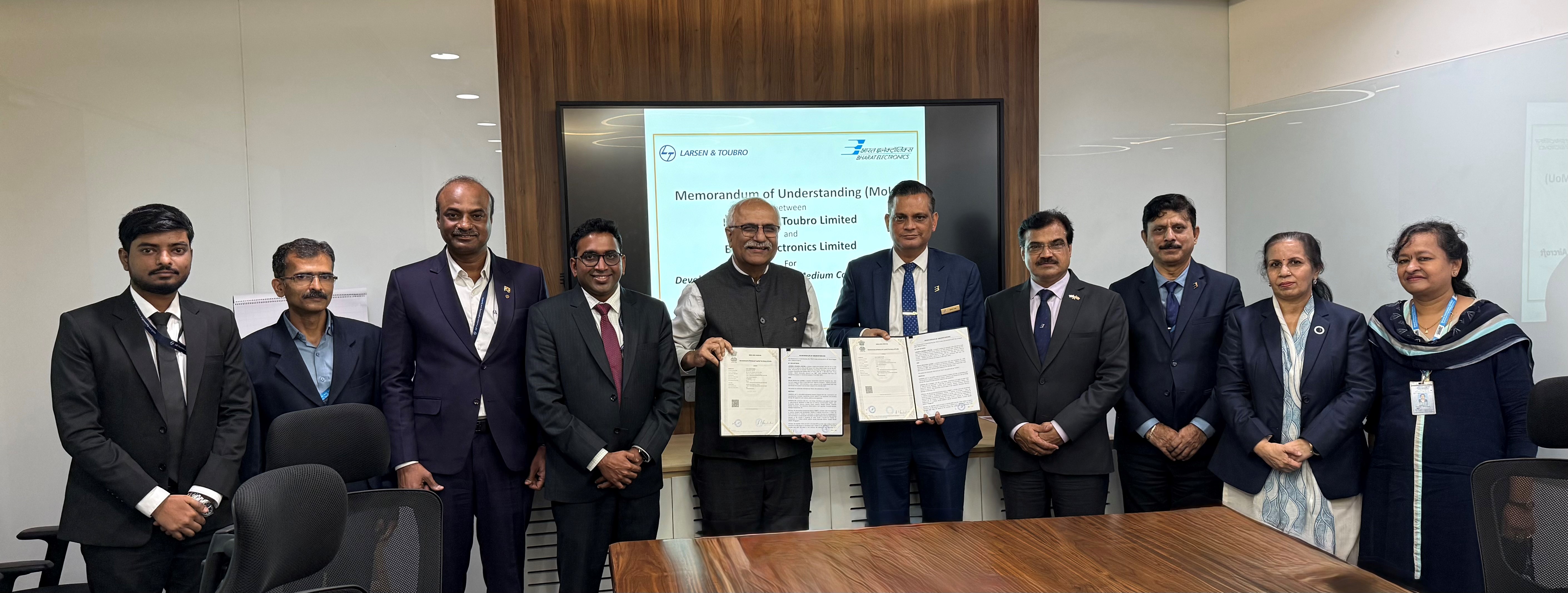 Officials from L&T and BEL at MoU-signing ceremony for AMCA project (Photo: Larsen & Toubro)
Officials from L&T and BEL at MoU-signing ceremony for AMCA project (Photo: Larsen & Toubro)
New Delhi: Two of India’s leading defence manufacturers have announced a strategic alliance to compete for the country’s most ambitious military aviation project. Larsen & Toubro (L&T) and Bharat Electronics Limited (BEL) formed a consortium to bid for the advanced medium combat aircraft (AMCA) programme.
The partnership positions the combined entity to respond to an “expression of interest” (EoI) notice issued by the government’s Aeronautical Development Agency, with submissions expected in the coming weeks. The AMCA represents India’s first indigenously designed fifth-generation stealth fighter aircraft, which is aimed at matching capabilities offered by advanced platforms like the American F-35 and Chinese J-20.
The AMCA programme, first conceived in 2009, has evolved into a cornerstone of India’s defence modernization strategy. The aircraft is designed to feature stealth capabilities, supercruise engines, and advanced sensor fusion technology that would place it among the world’s most sophisticated fighter jets.
Development of the twin-engine fighter has faced multiple delays, with the programme initially targeting first flight by 2025. Current projections suggest prototype testing may begin by 2028-2029, with potential induction into service not expected before the mid-2030s.
The project carries an estimated development cost exceeding ₹15,000 crore for the initial phase, with total programme costs potentially reaching ₹50,000 crore when factoring in production and lifecycle support.
Industry expertise combination
The L&T-BEL consortium brings complementary strengths to the competition. L&T’s engineering capabilities span complex systems integration, manufacturing precision components, and project management for large-scale defence programmes. The company has previously delivered critical components for the Tejas LCA (light combat aircraft), including carbon-fibre wing sections and landing gear systems.
BEL contributes decades of experience in mission-critical avionics, radar systems, and electronic warfare suites. The state-owned enterprise has developed indigenous alternatives to foreign systems, including active electronically scanned array radars and sophisticated electronic countermeasures.
Both companies have established track records in the indigenous fighter aircraft sector, having supplied essential components for the Tejas programme since its inception.
Evolving approach in defence sector
The formation of the consortium reflects India’s evolving approach to major defence programmes, increasingly favouring partnerships between private and public sector entities. This model aims to combine private sector efficiency with public sector experience and government backing.
Industry analysts note that the AMCA programme faces significant technical challenges, particularly in developing indigenous turbofan engines capable of supercruise performance. While the aircraft’s initial variants may rely on foreign engines, plans call for eventual integration of the indigenous Kaveri engine or its derivatives.
The project also requires mastery of stealth technology, including radar-absorbent materials and signature reduction techniques that remain closely guarded secrets among existing fifth-generation fighter manufacturers.
International factors
The AMCA programme operates within a broader context of international competition for India’s defence market. While the project emphasizes indigenous development, potential collaboration with foreign partners for critical technologies remains under consideration.
France’s Dassault Aviation and Sweden’s Saab have previously expressed interest in supporting India’s fifth-generation fighter ambitions. They offered technology transfer arrangements that could accelerate development timelines.
However, the government’s policy leans towards prioritizing domestic capability building over foreign dependency, which is in sync with the country’s broader strategic autonomy objectives.
Impact on market and industry
The AMCA programme is expected to generate substantial industrial activity across India’s aerospace sector. Successful development would position the country as only the fifth nation capable of designing and manufacturing fifth-generation fighter aircraft, joining the United States, Russia, China, and potentially the United Kingdom and South Korea.
The project could create thousands of high-skilled jobs in advanced manufacturing, software development, and systems engineering. It would also establish India as a potential exporter of sophisticated military aviation technology to allied nations.
The chairman and managing director of L&T, SN Subrahmanyan, described the collaboration as “a significant leap in our commitment to the modernization of India’s defence capabilities,” while his counterpart at BEL, Manoj Jain, emphasized the partnership’s role in “realizing India’s growing capabilities in defence technology.”
The consortium’s bid will compete against other potential partnerships and individual company proposals, with the Aeronautical Development Agency expected to announce selected partners by early 2026. The chosen industry partners will work alongside the Defence Research and Development Organisation and Hindustan Aeronautics Limited in developing India’s most advanced fighter aircraft.
